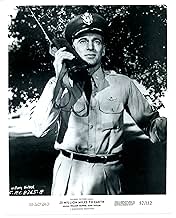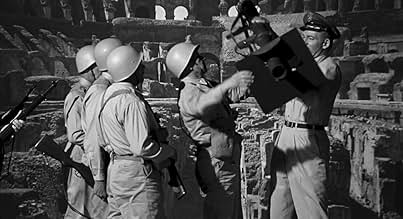À des millions de kilomètres de la Terre
- 1957
- Tous publics
- 1h 22min
Le premier vaisseau spatial américain à destination de Vénus s'écrase sur les côtes de la Sicile lors de son voyage de retour. Une dangereuse créature ressemblant à un lézard l'accompagne et... Tout lireLe premier vaisseau spatial américain à destination de Vénus s'écrase sur les côtes de la Sicile lors de son voyage de retour. Une dangereuse créature ressemblant à un lézard l'accompagne et devient rapidement gigantesque.Le premier vaisseau spatial américain à destination de Vénus s'écrase sur les côtes de la Sicile lors de son voyage de retour. Une dangereuse créature ressemblant à un lézard l'accompagne et devient rapidement gigantesque.
- Réalisation
- Scénario
- Casting principal
- Maj. Gen. A.D. McIntosh
- (as Thomas B. Henry)
- Pepe
- (as Bart Bradley)
- Farmer
- (non crédité)
- Technician
- (non crédité)
- Police Officer
- (non crédité)
- 1st Reuters News Correspondent
- (non crédité)
- American Embassy Aide
- (non crédité)
- Miss Reynolds
- (non crédité)
- Fisherman
- (non crédité)
- Minor Role
- (non crédité)
- Man Feeding Elephant
- (non crédité)
Avis à la une
What makes it better than average for a 1950s monster movie is the Ray Harryhausen animated Venusian, called a Ymir here. Photographed in atmospheric black and white, its progress from small caged creature to being loose and dangerous on the streets of Rome and fighting an elephant is engrossing. You can't help rooting for the Ymir, attacked along the way by dogs and soldiers. The Ymir becomes a character like Frankenstein's creation or the Creature from the Black Lagoon. Excellent work by Harryhausen, and far more interesting than the CGI dinosaurs from Spielberg's over praised (and underwhelming) Jurassic Park trilogy.
But once the monster appears on screen, none of that matters. Ray Harryhausen's animation is, as always, simply spellbinding, giving the monster, paradoxically, both a heightened reality (as it really is a physical object photographed in "real life") and a dreamlike quality. It's easy to see how Harryhausen's work set the standards for monster special effects until Star Wars and computer animation came along many years later.
This film is a particularly good example of his work for a number of reasons. There's only one monster (unlike the Sinbad/Jason/Titans movies), so all his effort is spent on that one "character". The monster also starts out small and grows huge by the end of the movie, allowing us to see it in a variety of settings. And, the fact that it's a humanoid (rather than a dinosaur or big octopus) allows it to "act" in a much more expressive manner (not unlike the original Kong).
So while this movie may qualify as little more than "MST3K" fodder as a science fiction work (did I mention how truly awful the script is?), as a piece of animation, it's a pure classic, deserving a space on your shelf next to King Kong, Snow White and Fantasia.
Thus, if you like somewhat-hokey 1950s science-fiction movies dealing with space or monsters, or in this case both of them, you should enjoy this little film. Most of it involves trying to cope with a specimen from Venus which quickly grows into a Godzilla-like monster (but smaller).
It seems a space ship had gone to Venus, but crashed on the way home. Only good-guy William Hopper, who used to help Perry Mason win courtroom cases on TV about this same time, survives the crash. The ship lands in a big body of water off Italy. The specimen, about the size of a trout, washes onshore where a little boy finds it and then shows it to his scientist-uncle. Within hours, it seems, the "thing" begins to break out of its ice encasing and - presto! - we have a small little Godzilla. Hours later, it's about the size of a small man. Very soon it's several times the size of a man.
Here's the good and bad news on the special-effects, which are crucial to a film like this. With Hall of Fame FX man Ray Harryhausen, you know you're going to get the best of what you can expect from a film 50 years ago. Compared to most films of its ilk during the '50s, this is good stuff and the creature looks and moves in a pretty realistic manner. The only "goof" is that in some scenes, such as the one in the barn, the monster looks about three feet high in some shots, and 20 feet in others. The scale gets thrown out of whack a few times and then several times later in the film. Thus, you never really know how big this lizard-creature is. Overall, however, it's still done extremely well for its time period.
There is a scene, too, where the alien creature fights an elephant! Once again, for something 50 years old, they did an excellent job re-creating what that fight might look like. It was well done....and how often do you see a monster fighting an elephant?? Pretty cool stuff. By the way, I watched the colorized version and the monster was green.
The acting is passable, too. Hopper, as "Col. Robert Calder," knows what's he doing, as do most others in here. Some of the actors are familiar faces from '50s and '60s television. The female interest - which is played down - has Joan Taylor as "Marisa Leonardo." She's a bit bland but not bad-looking. She reminded me of Phyllis Coates, from the first season of "The Adventures Of Superman."
All in all, if you're looking for a campy and fun, along with fast-moving classic-era sci-fi flick, this is highly recommended. You won't be bored.
Le saviez-vous
- AnecdotesThe film was originally going to be set in Chicago, with the rocket crashing in Lake Michigan. Right before submitting the idea to producer Charles H. Schneer, Ray Harryhausen decided to change the setting to Italy at the last minute, after deciding that he always wanted to go on vacation there.
- GaffesThe spaceship crashes into the water no more than 100 yards from the fishermen. Yet their boats are in no way affected by any disturbance of the water. A vessel that large crashing into the water would have created a large wake that would have at the least rocked the boats heavily, if not capsized them.
- Citations
Dr. Judson Uhl: You better tell them we're in a hurry and to roll up the red tape and put it into a drawer until this thing is over!
- Crédits fousOpening credits prologue: A FISHING VILLAGE IN SICILY
- Versions alternativesMany local TV stations delete the scene in which the Ymir kills an elephant from a zoo, claiming the scene is a needless depiction of cruelty to animals.
- ConnexionsEdited from Le Jour où la Terre s'arrêta... (1951)
Meilleurs choix
- How long is 20 Million Miles to Earth?Alimenté par Alexa
Détails
- Date de sortie
- Pays d’origine
- Langues
- Aussi connu sous le nom de
- La bestia de otro planeta
- Lieux de tournage
- Société de production
- Voir plus de crédits d'entreprise sur IMDbPro
- Durée1 heure 22 minutes
- Couleur
- Rapport de forme
- 1.85 : 1
Contribuer à cette page
























